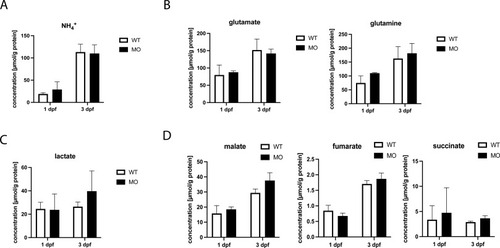
Metabolic alterations associated with hyperammonemia are not accounting for the cerebral phenotype. Wildtype zebrafish larvae were injected with MO targeting the zebrafish homologue of ASS1 or mock at the 1-cell stage followed by quantification of NH4+, glutamate and glutamine concentrations applying HPLC (A, B) or determination of TCA cycle intermediates including lactate using GC/MS (C, D) at 1 or 3 dpf, respectively. Notably, MO-injection was not associated with NH4+ accumulation (A). Moreover, concentrations of glutamate and glutamine were unaltered in the MO-injected zebrafish cohort when compared to negative control at either developmental stage (B). Consistently, ASS1-deficent zebrafish larvae exhibited unchanged concentrations of lactate and TCA cycle intermediates succinate, fumarate and malate as opposed to mock-injected controls (Csingle bondD), thereby excluding hyperammonemia-induced metabolic alterations as cause of the observed neuronal phenotype. Data are expressed as mean +/− SD in μmol per g protein (A-D; whole body lysates, N = 3 with 50 larvae per group and experiment, Student's t-test).
|

